GLOSSARY.
ALIYAH. literally means the act of going up. It is used in two senses:
- The honour of going up to the reading desk in the Synagogue, usually for the reading from the scroll of the Torah.
- Emigrating to the land of Israel. It is usual to speak of going up to Israel. Once in Israel one goes up to Jerusalem. And in Jerusalem one used to go up to the Temple. Both Jerusalem and the Temple were in fact built on hills, but the concept was also an increase in holiness.
AMORAIM. (singular Amora) The name applied to those Rabbis who lived in the Talmudic period. (3rd to 5th cent. CE.)
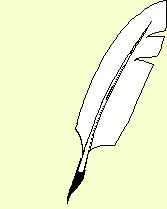
APOCRYPHA. When the Hebrew Bible was translated into Greek (in Alexandria) about 200 BCE, some extra Jewish writings were added to the text. As the Latin Vulgate was based upon the Greek text, the Roman Catholic "Old Testament" include these passages embedded in the text. When the Reformation in the church took place, scholars made translations from the original Hebrew text and the added passages were put into a separate section called the Apocrypha, meaning hidden texts. Although not part of the Jewish canon, some Talmudic Rabbis quoted from them as if they were.
ASHKENAZI. (Pl. Ashkenazim) Referring to Jews who lived in central Europe. Ashkenaz is the Hebrew for Germany. The name is mentioned in Genesis 10, 3. Ashkenazi Jews have a slightly different Hebrew accent from the Sephardim and the text of some of their prayers are also different. Within the Ashkenazi Jews, it was possible to detect differences in accent between areas like, Poland, Latvia, Hungary, etc.
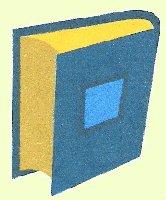
CHUMASH. Derived from the word Chamesh meaning five. A book containing the first five books of the Bible. This section is known as the Torah. The book is designed to help people follow the weekly readings in Synagogue. It is arranged showing the Sidra (Torah passage) followed by the Haftarah (prophetic reading) for each week, and these readings are usually accompanied by commentaries.
FLAVIUS JOSEPHUS. was the Latin name of Joseph ben Mattathias who lived in the 1st cent. CE. He was a Jewish historian who lived through the Roman War which destroyed the second Temple, and played a part in that war as an area commander of some of the Jewish fighters. He is a useful source of information of Jewish life and practices of the period. The main works, which he wrote in Latin, were The Jewish War, Antiquities of the Jews and Against Apion.
KITTEL. A white robe worn by some very orthodox Jews as a festival garment and also used eventually as a burial shroud.
MAIMONIDES. Moses ben Maimon also known as Rambam. (1135-1204) was born in Cordova, Spain moved first to Fez in Morocco and the to Fostat near Cairo. He was a scholar, philosopher and medical doctor. He was recognised as the greatest Jewish scholar of his age. His main works were Moreh Nevuchim (A Guide For The Perplexed) and Mishneh Torah (Code of Laws.)
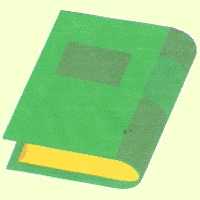
MISHNAH. A work by Tannaitic Rabbis under the leadership of Rabbi Judah Hanasi produced about 210 CE. It contains a collection of rulings and laws which had been passed on orally for a number of generations. The work is divided into six sections known as orders, and these in turn are divided according to subject matter into sections known as tractates. Each tractate is divided into chapters which have in them individual numbered mishnayot. So Pes. 4, 10 would be the tenth Mishnah in the fourth chapter of the tractate Pesachim (Passover). The six orders are: :
- Z'ra'im ~ Seeds
- Mo'ed ~ Festivals
- Nashim ~ Women
- N'zikin ~ Damages
- Kodashim ~ Holy Things
- Tohorot ~ Cleansing
References are given by the Tractate name with numbered subdivisions
MITSVAH.The word means commandment. In Judaism this refers to any statement in the Pentateuch which orders us to do this or not do that. The total number of these is 613. In colloquial usage it is also used to describe a good deed.
SEPHARDI. (Plural Sephardim) Referring to Jews living round the Mediterranean area. Sepharad = Spain. The word occurs in Obediah v. 20, but there it refers to a place in Asia Minor. Sephardi Jews have a different Jewish accent from the Ashkenazim and also have differences in a few prayers and practices.
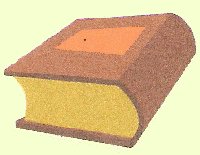
SHULCHAN ARUCH. Means a set table. This was the name code (or table) of laws and practices published in 1567 by Joseph Caro (1488-1575), a Sephardi Jew who lived in Safed in the Galilee, with additions from the Ashkenazi point of view by Moses Isserles (1520-1570) of Cracow. Because it contained both Sephardi and Ashkenazi rules this code became a major influence on Jewish practices after its publication. The Shulchan Aruch has four sections:
- Orah Hayim = Path of Life. (O.H.)
- Yore De'ah = Teacher of Knowledge (Y.D.)
- Even Ha-Ezer = The Stone of Help (E. H.)
- Hoshen Ha-Mishpat = Breastplate of Judgement (H.M.)
In the references on this websitel usually quote references in the form S. A. O. H. for Shulchan Aruch , Orah Hayim.
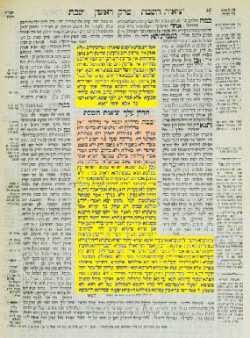
TALMUD. This usually refers to the Babylonian Talmud which was completed about 500 CE. It is a collection of the discussions, commentaries and decisions of the Rabbis from about 300 to 500 CE. These discussions known as the GEMARA (here coloured yellow  ) were an elaboration and clarification of the laws of the Mishnah (here coloured pink
) were an elaboration and clarification of the laws of the Mishnah (here coloured pink  ), which formed the basis of Talmudic debates. The other columns are commentaries on the commentaries by Rashi and the Tosafot together with notes about the sources of the quotations. The Palestinian Talmud (300-400 CE) is a less influential work as the discussions were cut short by persecutions.
), which formed the basis of Talmudic debates. The other columns are commentaries on the commentaries by Rashi and the Tosafot together with notes about the sources of the quotations. The Palestinian Talmud (300-400 CE) is a less influential work as the discussions were cut short by persecutions.
As the Talmud discusses the Mishnah sentence by sentence, the order and names of tractates are the same. From the Bomberg edition printed in Venice in 1520-3 each piece of paper was numbered say 23, and the first side was 23a and the reverse was 23b. So a Talmudic reference would be in the form Shab. 87b. which is the reverse side of page 87 of tractate Shabbat. Since 1520 all editions have followed the same page format.
TANNAITIC. Referring to those Rabbis who lived at the time that the Mishnah was being produced. (1st and 2nd cent. CE). They were known as Tannaim. The name is linguistically linked with the word Mishnah, for the Hebrew 'sh' and the Aramaic 't' can interchange.
 ) were an elaboration and clarification of the laws of the Mishnah (here coloured pink
) were an elaboration and clarification of the laws of the Mishnah (here coloured pink  ), which formed the basis of Talmudic debates. The other columns are commentaries on the commentaries by Rashi and the Tosafot together with notes about the sources of the quotations. The Palestinian Talmud (300-400 CE) is a less influential work as the discussions were cut short by persecutions.
), which formed the basis of Talmudic debates. The other columns are commentaries on the commentaries by Rashi and the Tosafot together with notes about the sources of the quotations. The Palestinian Talmud (300-400 CE) is a less influential work as the discussions were cut short by persecutions.



